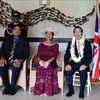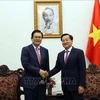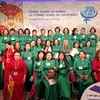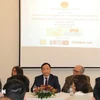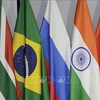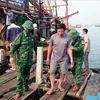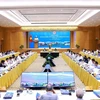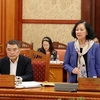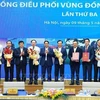Columnist Tran Van recently wrote an exclusive article on the tension in the East Sea following China’s illegal placement of its drilling rig Haiyang Shiyou-981 deep inside Vietnam’s exclusive economic zone and continental shelf. Following is a translation of his article under the above title.
“In an article published on Matichon on June 23, Ning Fuikui, Ambassador of the People’s Republic of China to the Kingdom of Thailand, rightly pointed out that the world recently has shown their deep disappointment with the wrongful acts of China such as drilling in the exclusive economic zone and continental shelf of another country and deliberately ramming until sinking the latter’s vessel operating normally in this area. These acts not only disregard international law, violate the Declaration on the Conduct of Parties in the East Sea (DOC), going against bilateral agreements reached by the two countries’ high-ranking leaders, but also aggravate the situation in the sea and escalate the tension in the region.
However, to find excuses for the action of China , Ambassador Ning did not hesitate to re-write history, fabricate facts and use twisted arguments in order to hide the truth. So what truth is Ambassador Ning trying to cover?
The Hoang Sa (Paracel) Archipelago belongs to Vietnam, not China
Vietnam has sufficient historical and legal grounds to assert its sovereignty over the Hoang Sa and Truong Sa (Spratly) Archipelagoes. Vietnam was the very first nation to occupy and then continuously and peacefully exercise its sovereignty over the two archipelagoes. Since at least the 17 th century, when these territories were still terra nullius, the Nguyen Lords of Vietnam (1558-1783) had established the Hoang Sa flotilla to administrate and exploit the archipelago. This fleet was sent every year to the archipelago to exploit resources, undertake geographical and geological measurements, conduct salvage operations, and erect landmarks and other utility buildings.
China , for its part, expressed no intention to claim sovereignty over the archipelago. In 1898, after ships Bellona and Himeji Maru had sunk in Hoang Sa and were looted by Chinese fishermen, the Deputy Governor of Guangdong stated that the archipelago were terra nullius which did not belong to China and were not administratively attached to any district of Hainan and that no authority was responsible for policing it. On the other hand, many Chinese documents, such as Haiwai jishi (Records of things overseas) 1696 or Hailu (Records at sea) 1820 acknowledge that this archipelago belongs to Vietnam.
The Cairo Conference in 1943 and the Potsdam Conference in 1945, to which China was a participant, declared that the islands in the Pacific that Japan had taken by force during World War 2 had to be returned and the territories that Japan had to return to China were Manju, Taiwan and Penghu only, not including Hoang Sa and Truong Sa. No official document was written, as Ambassador Ning claimed, that in 1946 China retook the Hoang Sa from Japan.
In particular, at the San Francisco Conference in 1951, the request that Japan recognise sovereignty of China over the Hoang Sa archipelago was rejected by the conference with 46 votes against. At this conference, head of the Vietnamese delegation, Prime Minister Tran Van Huu affirmed Vietnam’s sovereignty over Hoang Sa and Truong Sa, which met with no protest from all the 51 participating countries.
In fact, in 1956 and 1974, China took by force the eastern half and then the western half of Hoang Sa archipelago from the Republic of Vietnam . This act violated the prohibition of use of force against the territorial integrity of another state, a peremptory norm of international law. This aggression, along with other wrongful acts of China since the beginning, has met with strong protests from Vietnam .
That Ambassador Ning cited a number of documents from the Democratic Republic of Vietnam before 1974 to argue that Vietnam recognised the sovereignty of China over this archipelago is a twisted argument. According to the Geneva Accords of 1954, the Democratic Republic of Vietnam was assigned to administrate the northern half of Vietnam from the 17th parallel, which did not include the Hoang Sa archipelago. China must be well aware of this matter.
China is violating Vietnam ’s sovereign right and jurisdiction
Although Ambassador Ning had misled the public opinion on the question of sovereignty, he failed to cover another truth. That is, by all means, the oil rig is located in Vietnam’s exclusive economic zone and continental shelf. I would like to invite Ambassador Ning to read the basic documents of the law of the sea to see that both the so-called “17-nautical-mile-water” of Triton Island and the “baseline of the Hoang Sa Archipelago” claimed by China are against the 1982 United Nations Convention on the Law of the Sea.
Therefore, China has violated Vietnam’s sovereign right and jurisdiction by unilaterally drilling in an area located about 60-80 nautical miles deep inside Vietnam ’s exclusive economic zone and continental shelf. Vietnam has consistently and vehemently protested against all encroachments into its waters. As Ambassador Ning rightly pointed out, China has, on a number of occasions, intruded into this area to conduct surveys. In response to such intrusions, Vietnam has sent law enforcement vessels to the area to give warnings and to chase away the Chinese vessels conducting illegal activities therein and has, at the same time, sent Notes Verbales to China to protest. All are still on the record.
Ambassador Ning also feels free to make accusations without evidence. While stated that Vietnam has sent “frogmen” into this area and Vietnamese ships have rammed Chinese ships for a total of 1,416 times, Ambassador Ning and the government of China could not provide any evidence to support these wrongful statements. In the opposite, video clips provided by Vietnam and reports from international journalists present at the scene have told a completely different story. It is China who has used a large number of vessels of different types, including military ships with ready-to-deploy weapons (at times reaching up to 140), to escort the oil rig. Chinese ships have deliberately rammed and fired water cannon at Vietnamese vessels, causing injuries to dozens of officers, damaging many vessels of Vietnam‘s civilian law enforcement agencies, and even going as far as sinking a Vietnamese fishing boat.
It is ridiculous that Ambassador Ning cited “large numbers of obstacles, including fishing nets and floating objects” in the waters to accuse Vietnam. They were nothing but pieces broken away from Vietnamese ships after being violently hit by Chinese vessels which are another set of evidence of the brutality of Chinese vessels.
All the evidence of China ’s violent and aggressive behaviours are publicly available for anyone who want to check them out. Thai friends could also ask news agencies having offices in Thailand who have sent reporters to the scene to have more information.
Fuelled by anger towards the above-mentioned behaviours of China, Vietnamese people had spontaneous protest demonstrations in some provinces of Vietnam to express their patriotism. Some people took advantage of the Vietnamese people’s patriotism to do some provoking and illegal acts, which caused adverse effects towards some of Chinese workers and foreign investors in Vietnam.
Vietnamese Government immediately took resolute measures such as arresting the offenders, reinforcing security and compensating affected enterprises. To date, the situation has been stabilised and affected enterprises have resumed their normal production. All the efforts of the Vietnamese Government have received appraisals from foreign investors. However, Ambassador Ning has unfailingly accused the Vietnamese Government and deliberately distorted the fact. Instead of rushing into blaming the Vietnamese Government, it is wondered that Ambassador Ning should have asked himself what the Chinese government had done for Japanese investors who were also affected by the anti-Japan riots in China two years ago.
China is ignoring Vietnam’s goodwill to settle the current situation through dialogue and other peaceful means
Since the beginning of the operation of Hayang Shiyou 981, Vietnam has made utmost efforts to communicate and conduct dialogue with China to demand it to immediately stop all violations of Vietnam’s sovereign right and jurisdiction, and to substantially negotiate to resolve the issues at sea between the two countries. Vietnam has conducted more than 30 diplomatic communications with relevant Chinese authorities. The latest was the invitation to State Councillor of China Yang Jiechi to Hanoi by Deputy Prime Minister and Foreign Minister of Vietnam Pham Binh Minh to exchange views on this matter. But China has, to date, stubbornly refused to withdraw the oil rig and to start negotiations to bring the situation back to normal.
Agreeing to the idiom about keeping promises quoted by Ambassador Ning, I strongly urge the Chinese government to honour the promise made by Mr. Deng Xiaoping, the then Deputy Prime Minister of China, to Mr. Le Duan, the then First Secretary of Communist Party of Vietnam, in 1975 to resolve the disagreement between Vietnam and China over the Hoang Sa through friendly negotiations, as well as honouring all other relevant bilateral agreements between the two countries.
Vietnam has actively supported the respect of international law, peace, stability and development in both the Gulf of Thailand and the East Sea
Vietnam has proved to be a strong supporter of international law, peace, stability and development in the Gulf of Thailand and the East Sea with its concrete deeds. In 1997, Vietnam and Thailand successfully signed the maritime boundary delimitation agreement on the Gulf of Thailand, the first maritime boundary agreement in Southeast Asia after the coming into force of the United Nations Convention on the Law of the Sea and the first maritime boundary agreement on the Gulf of Thailand . Vietnamese and Thai governments also undertook concrete cooperative activities in the insurance of maritime security and protection of marine living resources in this area as well as carried out join patrols.
Besides, Vietnam has successfully signed maritime boundary delimitation agreements with many other countries in the Gulf of Thailand and the East Sea including with China on the Gulf of Tonkin in 2000, which was the first maritime boundary agreement ever signed by China. Vietnam has also been undertaking many important bilateral and multilateral cooperative initiatives in the East Sea in different sectors such as marine scientific research, management and conservation of natural resources, exploration and exploitation of mineral resources (such as the negotiations between Vietnam, Thailand and Malaysia for joint development in the Gulf of Thailand). In particular, just before the unilateral drilling of China , Vietnam and China agreed to set up a group to discuss joint development at sea.
Continuing this policy of supporting international law, peace, stability and development in the region, Vietnam will resolutely use all peaceful means allowed by international law to safeguard its legitimate rights and interests. Vietnam hopes that governments and peoples from all around the world, including the government and people of Thailand, will continue to stand shoulder-to-shoulder with the people of Vietnam in these goodwill efforts.
Since Ambassador Ning seems to have a particular sense for quotations. I would like to end this note by quoting an ancient Chinese proverb: “Look inside you before blaming others.” Ambassador Ning should look into China ’s own behaviours to see why the country has been criticised by public opinion instead of groundlessly blaming others”.-VNA
“In an article published on Matichon on June 23, Ning Fuikui, Ambassador of the People’s Republic of China to the Kingdom of Thailand, rightly pointed out that the world recently has shown their deep disappointment with the wrongful acts of China such as drilling in the exclusive economic zone and continental shelf of another country and deliberately ramming until sinking the latter’s vessel operating normally in this area. These acts not only disregard international law, violate the Declaration on the Conduct of Parties in the East Sea (DOC), going against bilateral agreements reached by the two countries’ high-ranking leaders, but also aggravate the situation in the sea and escalate the tension in the region.
However, to find excuses for the action of China , Ambassador Ning did not hesitate to re-write history, fabricate facts and use twisted arguments in order to hide the truth. So what truth is Ambassador Ning trying to cover?
The Hoang Sa (Paracel) Archipelago belongs to Vietnam, not China
Vietnam has sufficient historical and legal grounds to assert its sovereignty over the Hoang Sa and Truong Sa (Spratly) Archipelagoes. Vietnam was the very first nation to occupy and then continuously and peacefully exercise its sovereignty over the two archipelagoes. Since at least the 17 th century, when these territories were still terra nullius, the Nguyen Lords of Vietnam (1558-1783) had established the Hoang Sa flotilla to administrate and exploit the archipelago. This fleet was sent every year to the archipelago to exploit resources, undertake geographical and geological measurements, conduct salvage operations, and erect landmarks and other utility buildings.
China , for its part, expressed no intention to claim sovereignty over the archipelago. In 1898, after ships Bellona and Himeji Maru had sunk in Hoang Sa and were looted by Chinese fishermen, the Deputy Governor of Guangdong stated that the archipelago were terra nullius which did not belong to China and were not administratively attached to any district of Hainan and that no authority was responsible for policing it. On the other hand, many Chinese documents, such as Haiwai jishi (Records of things overseas) 1696 or Hailu (Records at sea) 1820 acknowledge that this archipelago belongs to Vietnam.
The Cairo Conference in 1943 and the Potsdam Conference in 1945, to which China was a participant, declared that the islands in the Pacific that Japan had taken by force during World War 2 had to be returned and the territories that Japan had to return to China were Manju, Taiwan and Penghu only, not including Hoang Sa and Truong Sa. No official document was written, as Ambassador Ning claimed, that in 1946 China retook the Hoang Sa from Japan.
In particular, at the San Francisco Conference in 1951, the request that Japan recognise sovereignty of China over the Hoang Sa archipelago was rejected by the conference with 46 votes against. At this conference, head of the Vietnamese delegation, Prime Minister Tran Van Huu affirmed Vietnam’s sovereignty over Hoang Sa and Truong Sa, which met with no protest from all the 51 participating countries.
In fact, in 1956 and 1974, China took by force the eastern half and then the western half of Hoang Sa archipelago from the Republic of Vietnam . This act violated the prohibition of use of force against the territorial integrity of another state, a peremptory norm of international law. This aggression, along with other wrongful acts of China since the beginning, has met with strong protests from Vietnam .
That Ambassador Ning cited a number of documents from the Democratic Republic of Vietnam before 1974 to argue that Vietnam recognised the sovereignty of China over this archipelago is a twisted argument. According to the Geneva Accords of 1954, the Democratic Republic of Vietnam was assigned to administrate the northern half of Vietnam from the 17th parallel, which did not include the Hoang Sa archipelago. China must be well aware of this matter.
China is violating Vietnam ’s sovereign right and jurisdiction
Although Ambassador Ning had misled the public opinion on the question of sovereignty, he failed to cover another truth. That is, by all means, the oil rig is located in Vietnam’s exclusive economic zone and continental shelf. I would like to invite Ambassador Ning to read the basic documents of the law of the sea to see that both the so-called “17-nautical-mile-water” of Triton Island and the “baseline of the Hoang Sa Archipelago” claimed by China are against the 1982 United Nations Convention on the Law of the Sea.
Therefore, China has violated Vietnam’s sovereign right and jurisdiction by unilaterally drilling in an area located about 60-80 nautical miles deep inside Vietnam ’s exclusive economic zone and continental shelf. Vietnam has consistently and vehemently protested against all encroachments into its waters. As Ambassador Ning rightly pointed out, China has, on a number of occasions, intruded into this area to conduct surveys. In response to such intrusions, Vietnam has sent law enforcement vessels to the area to give warnings and to chase away the Chinese vessels conducting illegal activities therein and has, at the same time, sent Notes Verbales to China to protest. All are still on the record.
Ambassador Ning also feels free to make accusations without evidence. While stated that Vietnam has sent “frogmen” into this area and Vietnamese ships have rammed Chinese ships for a total of 1,416 times, Ambassador Ning and the government of China could not provide any evidence to support these wrongful statements. In the opposite, video clips provided by Vietnam and reports from international journalists present at the scene have told a completely different story. It is China who has used a large number of vessels of different types, including military ships with ready-to-deploy weapons (at times reaching up to 140), to escort the oil rig. Chinese ships have deliberately rammed and fired water cannon at Vietnamese vessels, causing injuries to dozens of officers, damaging many vessels of Vietnam‘s civilian law enforcement agencies, and even going as far as sinking a Vietnamese fishing boat.
It is ridiculous that Ambassador Ning cited “large numbers of obstacles, including fishing nets and floating objects” in the waters to accuse Vietnam. They were nothing but pieces broken away from Vietnamese ships after being violently hit by Chinese vessels which are another set of evidence of the brutality of Chinese vessels.
All the evidence of China ’s violent and aggressive behaviours are publicly available for anyone who want to check them out. Thai friends could also ask news agencies having offices in Thailand who have sent reporters to the scene to have more information.
Fuelled by anger towards the above-mentioned behaviours of China, Vietnamese people had spontaneous protest demonstrations in some provinces of Vietnam to express their patriotism. Some people took advantage of the Vietnamese people’s patriotism to do some provoking and illegal acts, which caused adverse effects towards some of Chinese workers and foreign investors in Vietnam.
Vietnamese Government immediately took resolute measures such as arresting the offenders, reinforcing security and compensating affected enterprises. To date, the situation has been stabilised and affected enterprises have resumed their normal production. All the efforts of the Vietnamese Government have received appraisals from foreign investors. However, Ambassador Ning has unfailingly accused the Vietnamese Government and deliberately distorted the fact. Instead of rushing into blaming the Vietnamese Government, it is wondered that Ambassador Ning should have asked himself what the Chinese government had done for Japanese investors who were also affected by the anti-Japan riots in China two years ago.
China is ignoring Vietnam’s goodwill to settle the current situation through dialogue and other peaceful means
Since the beginning of the operation of Hayang Shiyou 981, Vietnam has made utmost efforts to communicate and conduct dialogue with China to demand it to immediately stop all violations of Vietnam’s sovereign right and jurisdiction, and to substantially negotiate to resolve the issues at sea between the two countries. Vietnam has conducted more than 30 diplomatic communications with relevant Chinese authorities. The latest was the invitation to State Councillor of China Yang Jiechi to Hanoi by Deputy Prime Minister and Foreign Minister of Vietnam Pham Binh Minh to exchange views on this matter. But China has, to date, stubbornly refused to withdraw the oil rig and to start negotiations to bring the situation back to normal.
Agreeing to the idiom about keeping promises quoted by Ambassador Ning, I strongly urge the Chinese government to honour the promise made by Mr. Deng Xiaoping, the then Deputy Prime Minister of China, to Mr. Le Duan, the then First Secretary of Communist Party of Vietnam, in 1975 to resolve the disagreement between Vietnam and China over the Hoang Sa through friendly negotiations, as well as honouring all other relevant bilateral agreements between the two countries.
Vietnam has actively supported the respect of international law, peace, stability and development in both the Gulf of Thailand and the East Sea
Vietnam has proved to be a strong supporter of international law, peace, stability and development in the Gulf of Thailand and the East Sea with its concrete deeds. In 1997, Vietnam and Thailand successfully signed the maritime boundary delimitation agreement on the Gulf of Thailand, the first maritime boundary agreement in Southeast Asia after the coming into force of the United Nations Convention on the Law of the Sea and the first maritime boundary agreement on the Gulf of Thailand . Vietnamese and Thai governments also undertook concrete cooperative activities in the insurance of maritime security and protection of marine living resources in this area as well as carried out join patrols.
Besides, Vietnam has successfully signed maritime boundary delimitation agreements with many other countries in the Gulf of Thailand and the East Sea including with China on the Gulf of Tonkin in 2000, which was the first maritime boundary agreement ever signed by China. Vietnam has also been undertaking many important bilateral and multilateral cooperative initiatives in the East Sea in different sectors such as marine scientific research, management and conservation of natural resources, exploration and exploitation of mineral resources (such as the negotiations between Vietnam, Thailand and Malaysia for joint development in the Gulf of Thailand). In particular, just before the unilateral drilling of China , Vietnam and China agreed to set up a group to discuss joint development at sea.
Continuing this policy of supporting international law, peace, stability and development in the region, Vietnam will resolutely use all peaceful means allowed by international law to safeguard its legitimate rights and interests. Vietnam hopes that governments and peoples from all around the world, including the government and people of Thailand, will continue to stand shoulder-to-shoulder with the people of Vietnam in these goodwill efforts.
Since Ambassador Ning seems to have a particular sense for quotations. I would like to end this note by quoting an ancient Chinese proverb: “Look inside you before blaming others.” Ambassador Ning should look into China ’s own behaviours to see why the country has been criticised by public opinion instead of groundlessly blaming others”.-VNA
